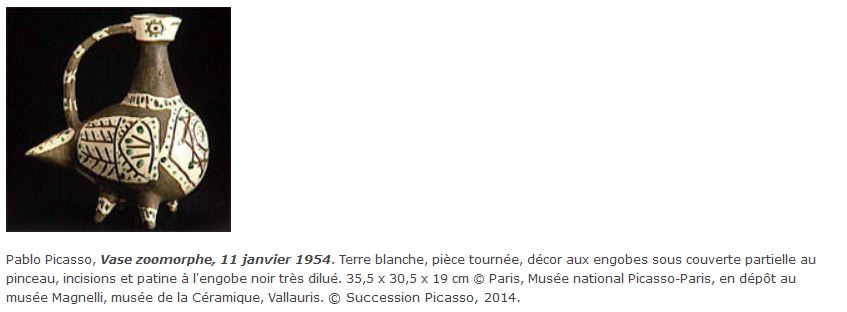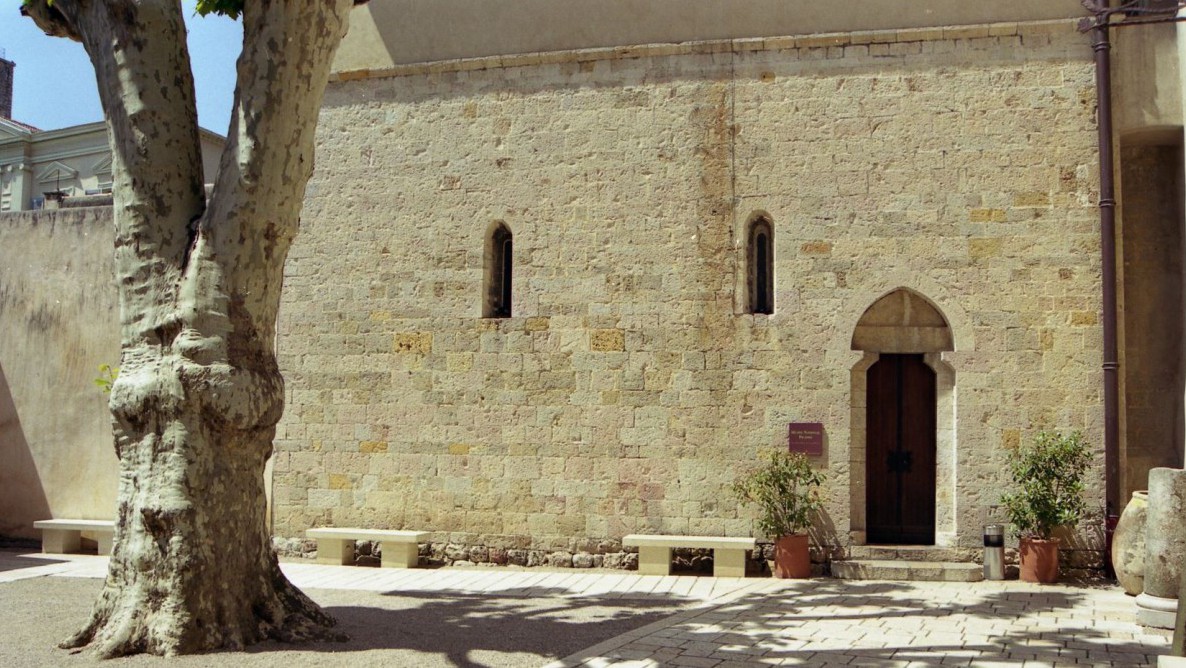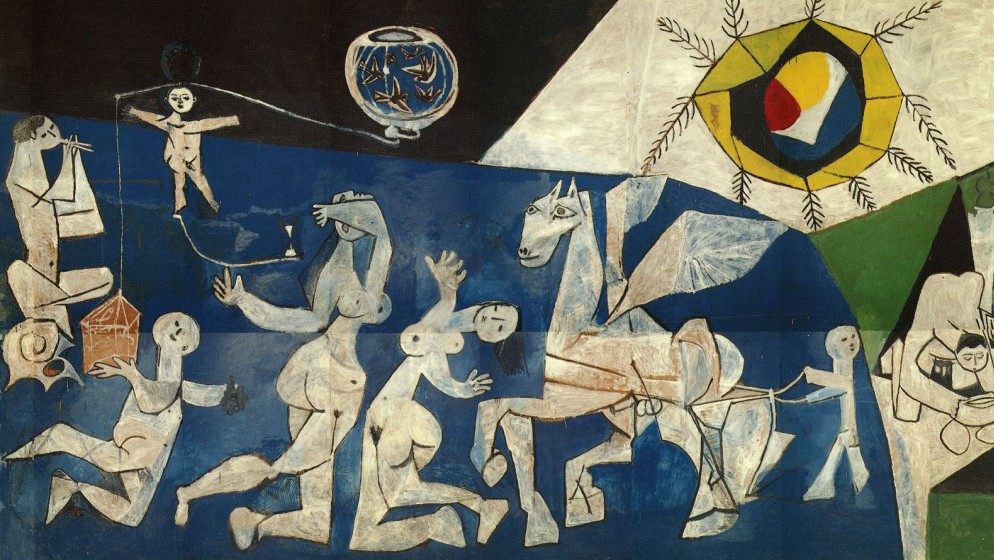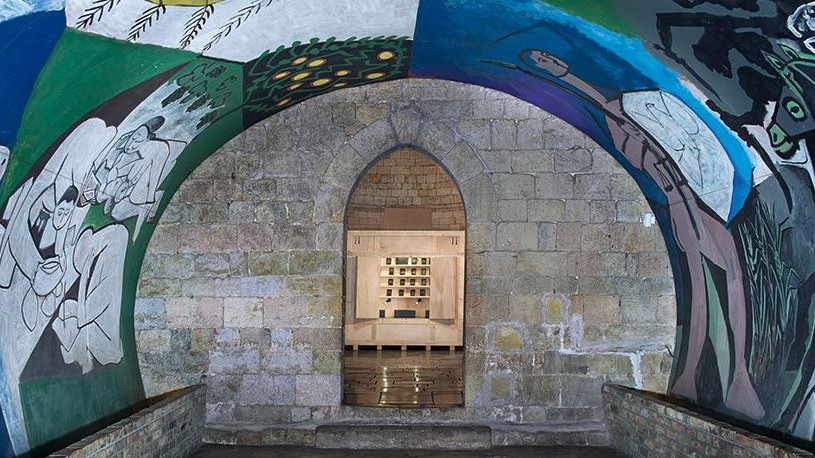Expo
PABLO PICASSO
The chapel
The Romanesque Chapel

The choice of the chapel of Vallauris to install War and Peace: The two works of Picasso War and Peace were installed in the chapel of the castle of Vallauris in 1959.
Picasso's choice of the chapel for the construction of his Temple of Peace is part of a movement to rediscover sacredart,
which was undeniably popular in the 1950s: Matisse
completes the decoration of the Rosary Chapel in Vence, Chagall - as well
Bonnard, Léger, Germaine Richier - are involved in the decoration of
The Church of the Plateau of Assy, Our Lady of All Grace. It begins
also to work on his monumental Biblical Message, which he intended to
first to another chapel in Veneto before donating it to the state.
Pablo Picasso, aware of the profound symbolism of the place and seduced by the
rigorous proportions of the austere building, chooses the chapel of the
Vallauris Castle.
The ancient building helps to give to War andPeace, with its obvious references to ancient art, even rockart,
a sacred and universal anchorage. "It is not very clear in this
the artist told Claude Roy, and I would like to see no
light it up, that visitors have candles in their hands, that they
walk along the walls as in prehistoric caves,
discovering the figures, that the light moves on what I have painted, a
little candlelight."
Luc Thévenon, curator of the Masséna Museum in Nice presents the building that now houses Picasso's War and Peace:
"Aldebert,
Bishop of Antibes and co-lord of this place with his older brother
Guillaume Ganceran, cedes his stronghold of Vallauris to the monastery of Lérins
December 9, 1038. This area is growing in the possessions
sold in 1046 by Pierre Signier and his son Guillaume at the time of
their habit-taking in Lérins.
Donations are first contested
Aldebert's rights holders, notably Foulques de Grasse, who
occupies them to such an extent that Pope Honorius II must threaten him
1124 to obtain a handover in 1131. The
Counts of Provence confirm the rights of the abbey of Lérins several
times in the 12th century. In 1227, the abbot father had authorized Lady
Aiceline to found a small community of women using certain
buildings whose location remains highly controversial. During the course of the year,
12th century, the abbey built a castle and chapel for the
residence of the prior, delegated lord of the fiefdom, helped at least two
imposed by the statutes of 1353. If the chapel has been preserved,
the present castle is a reconstruction of 1568 whose staircase
Renaissance is classified.
The chapel is a unique navebuilding, its elevations give it an unusual monumentality. Two spans covered with a broken cradle vault are articulated to an apse in a cul-de-four
by a wide broken bow. The walls provide a way to
stereometry but with visible traces of mortar. Has
outside, this device has elements of a geological nature
grey, pink, ochre cobblestones, which give a lot of charm to
The building. A simple square section headband runs to the limit
vault walls without a return on pilasters. The berries, two oppositeby
spans, are either framed with very fitted clavicles (to the south), or
surmounted by a monolith linch cut in arched technique
much more frustrated. The very high apse has a large
more regular to the perfect stereotomy. Largely visible from
inside the castle (low room in the basement and first floor with
axial window) it is reinforced by a high plinth resting on a
bed of coarse blocks.
No date specifies consecration
Chapel: This building was built after the middle of the
12th century, then redesigned or restored at the beginning of the 13th century, dates back to
which connects the beautiful apse and the southern bays. The south gate,
with its four neat but purely geometric consoles, should
be attributed to this restoration.
St. Anne's Church in
Vallauris is part of a large set of buildings in
Eastern Provence. It is very close to Sainte-Anne du Suquet and
the chapter house of Saint-Honorat which are two other
Lenin ian constructions. More broadly, it needs to be placed in a
ample movement of renovation, the latest impulse of Romanesque art in this
region, evidenced by one- or two-decade lags
the Church of St. Cezaire and in the
the mountain environment, those of Girs, Gréolières-Hautes or
Coursegoules in particular.
Caption: Romanesque chapel of Vallauris, Pablo Picasso National Museum, War and Peace. © 20th century National Museums of the Alpes-Maritimes © cliché P.Gérin.
Picasso in Vallauris

after
World War II, Pablo Picasso chose to live and
working on the French Riviera. His strong attachment to the Mediterranean
takes him in turn to Antibes and before Cannes and Mougins, to
Vallauris where he stayed from 1948 to 1955. Installed in his workshop in The Fournas,
former perfume factory, he works intensely,
works and experimented with a new technique for him:
ceramics that particularly caught his attention and who motivated
probably its installation in Vallauris, a city known for its industry
Potter.
These are thousands of objects that Picasso will create in theMadoura ceramicworkshop, recently directed by Georges and Suzanne Ramié.
Plates, dishes, vases, pitchers and other earthenware were
painted and decorated with enamels and metal oxides, which, by the way,
their nature and to the delight of the artist, mortgaged
always the end result. But the same objects, out of the turn of the
potter, could also be transformed. A few clever twists
transformed them into animals or female nudes, wildlife or
tanagra.
If Picasso's stay in Vallauris remains
undoubtedly marked by this prolific ceramic creation,
however, the artist did not abandon the usual techniques such as
there
linoleum engraving or sculpture of which he also revolutionized the principle of execution by incorporating recovered objects (The Goat, The Woman with theStroller, La Guenon and her littleone ...) or the painting that then begins an explicit dialogue with the works of the great masters (Portraitof a painter after Le Greco, Les Demoiselles on the banks of the Seine after Courbet).
In this post-war period, Picasso's art also makes way for certain episodes of contemporaryhistory. Massacre in Korea, The Massgrave and the famous Portrait of Stalin
demonstrate the political commitment of the artist who, despite his
recent membership of the Communist Party, continues to question
and is working on its transformation without in any way agreeing with the
precepts of socialist realism. The terrible developments
recent history are therefore not absent in Picasso's work but
they are not explicitly included. Clues only allow
to think that the precarious times that the world has lived in remain present
in his work: dislocated objects that can be seen in the
many still lifes of this period, human skulls or animals,
lamps scattering a blatant light that frames severely
all in all. The abrupt shapes That Picasso gives to objects,
shades of grey to which he limits his palette are, no doubt,
elements that make the artist's statement understandable:
A saucepan can scream too! Anything can scream!
Picasso's work during the seven years he lived in Vallauris is also rich in what he lived there. Françoise Gilot,
his then-girlfriend, as did Claude and Paloma, the children of the
couple are frequently depicted in his painting. They go to
their occupations or appear frontally on the canvas. The landscape
Mediterranean, the very city of Vallauris, with the black fumes of the
ovens at the time of cooking, are also the themes dealt with by
The artist. Just like the shadow created by city fumes
appears, in some representations of female nudes (
TheShadow, The Shadow on theWoman,
December 1953), that of the man on the elongated body of
women, even as the relationships of Pablo and Françoise
are in serious deterioration.
From the moment she met Jacqueline Roque
- young girl who will become his second wife - the painter makes him
place in his paintings. This was the time when Vallauris experienced great
turmoil. Indeed, Picasso's presence is at the origin of a
true artistic emulation: Victor painters and sculptors
Brauner, Marc Chagall, Edouard Pignon, Ozenfant, Prinner... Come
work in ceramic workshops.
The Restoration of War and Peace in 1998

Pablo Picasso, The War, 1952. Oil on wood, isorel, 4.70 m x 10.20 m. © Vallauris, chapel, Picasso National Museum. © Picasso Estate, 2014.
The Restoration of War and Peace
was carried out on-site in Vallauris during the first quarter of
1998, under the control of the restoration department of the museums of
France. The analyses were carried out by the museum laboratory in
France in Paris and the National
photoprotection in Clermont-Ferrand.
The Restoration of War and Peace, Study of the Work and Discovery
The work,
painted with a water-based material, not varnished, had not been
restored since its inception in 1952. The colors were clogged and
water drippinghad caused the paint to peel off and
money laundering. The support of the work, 46 panels of isorel on a
wooden frame attached to the wall by metal legs, had
also suffered from moisture causing swelling and misdemeanour
panels at the base. The dust and rubble had
accumulated on the back of the panels, causing deformations of the
curve.
During the dismantling, was discovered on the ancient plaster of the
wall, a charcoal drawing depicting a human figure. there
restoration involving a deposit for which the completion of the
counter-forms respecting the curvature of each of the panels was
necessary. The signs thus moved without altering their
curvature were then deposited on cradles also at the same
Forms. The cleaning consisted, depending on the area, in washing or scrubling,
then refixing the offending parts, and reconstructing the few
small gaps. This cleaning allowed the colors to be refreshed
and the re-enhancement of dullness and brilliance. The panels
then reassembled with counter-forms on the old
structure, in excellent condition. The charcoal drawing was refixed, and then
photographed, was covered during the reassembly.
Restoration, preventive conservation and respect for the place
there
restoration was undertaken after extensive work
remediation of the chapel, aimed at removing external causes
moisture. This work was continued during the filing of the
panels by stripping the vault restoring the initial capacity
guarantor of the proper preservation of the wooden structures. there
museography has been reviewed with the discretion required to respect the
conditions for the presentation of the work intended by Picasso and the
sobriety of 12th century architecture. Lighting the work
in particular has been taken up. The spectacular restoration of this work
provided by the restoration service of the museums of France, of which
Gilles Barabant, research fellow in the museum restoration department
France in collaboration with Daniel Jaunard, Patrick Mandon and Jean
Perfettini, cabinetmakers, Nathalie and Aloes de Becdelièvre,
restorers of the pictorial layer, Florence Cremer, conservator of
Mural.
Rates
Full fare: 6 euros
Reduced rate: 3 euros (groups from 10 people, seniors, students)
Free: children up to 18 years old included and habitants of Vallauris Golfe-Juan.
CALL THE MUSEUM TO BUY YOUR PLACES IN AVANCE OR FOR ALL SPECIFIC QUESTIONS
Open on sunday

 StayHostel, ...
StayHostel, ... VisitMuseums, ...
VisitMuseums, ... Go outRestaurants, ...
Go outRestaurants, ... ShopsFashion, ...
ShopsFashion, ... LeisuresBeaches, sports, ...
LeisuresBeaches, sports, ... ServicesTourism, ...
ServicesTourism, ...
















